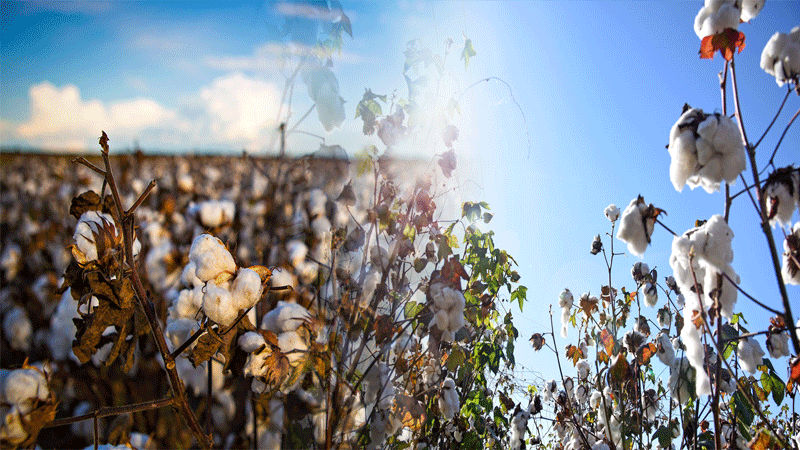Cotton is a basic raw material to the largest industrial sector and the largest export earnings which should be given its due share, PKI President proposed.

The Pakistan Kissan Ittehad (PKI) has proposed engaging technology-providing seed companies to revitalize cotton breeding programs by taking into account local issues such as heat tolerance and uniform maturity, which are suitable for machine picking and high-density production.
While speaking to the media, PKI President Khalid Mahmood Khokhar claimed that agriculture is an important pillar of the economy that has been overlooked by previous governments.
There is an urgent need to examine crops that make significant contributions to the economy and assign them the appropriate priority level. Crops that are a drain on the economy or natural resources must be avoided and only grown for domestic consumption.
Cotton is a basic raw material to the largest industrial sector and the largest export earnings which should be given its due share, he proposed.
Pakistan’s existing resources have the potential to produce 15–18 million bales (water and soil). Cotton’s historical area in Pakistan was 3.2 million hectares, but it is now less than 2 million hectares.
Pakistan used to produce over 14 million bales per year, but that number has now dropped to 7 million bales. On the other hand, he claims that demand in the local textile industry has increased to 15–16 million bales, with imports filling the gap.
Cotton growers should be assisted in increasing area and productivity, according to Khalid, by providing equal opportunity and a level playing field in the region. “We can hardly think of any country that grows cotton without providing subsidies in the form of direct assistance, insurance, lower input prices, support prices, etc.,” he added.
He claimed that government funds for cotton research are even lower in Bangladesh and Nepal. The PCCC, the country’s top research and development organisation, relies on Rs 50 per bale of cotton collected from the textile industry.
They have not paid for the last three years, and the PCCC has reduced its R&D spending. Cotton cess receivable from the textile industry has risen to more than Rs 3.2 billion. The scientists and staff of the PCCC have not been paid their salaries and pensions for the last six months due to less recovery, and the government has not given any supplementary grants.
He proposed to enhance the cotton R&D investment by at least 2% of the agriculture GDP in the next three years.
The productivity gap between progressive and non-progressive growers (small or large growers) is enormous. In the same village, with the same soil type, one grower gets 40 mounds per acre, while the neighbouring farmer gets 12 mounds per acre.
This could be due to a lack of access to technology, a lack of liquidity, substandard input, or a lack of agricultural department advisory services.
It is critical to re-energize the provincial agriculture extension department in order to educate farmers and strictly enforce the quality of inputs, particularly fertilizers, seeds, and pesticides. If this gap can be reduced by half, five million additional bales can be added with the same resources or area allocation, according to Khalid.
He also stressed the need for promoting farm mechanization among small growers as well through service providers. Besides this ginning factories be upgraded by giving them a cash subsidy for the most efficient and modern technology. Cotton ginning in Pakistan is the weakest link after cotton “seed” and needs immediate attention.
Pakistan has the capacity to gin 14 million bales of cotton in 1300 ginning factories with primitive technology copied from 1947 USA-made machines.
According to Khalid Khokhar, a conservative estimate of the cottonseed business is Rs 30–40 billion, while over 700 seed companies are unable to supply the required quantity of cotton seed, and the gap is filled either by substandard Benola or by illegal seed entrepreneurs operating in villages.
None of the seed companies were able to gain the cotton growers’ trust in their ability to provide quality seed and purity. It is critical that multinational seed companies with a presence in Pakistan in the maize or vegetable seed business be approached about entering this market. All that is required is effective seed rule enforcement.
Cotton breeding programs in various research institutes must be discussed collaboratively with clear objectives and consideration for national requirements. Heat tolerance is the key factor to consider as a primary breeding goal. Other areas for future cotton cultivation include single stem erect types suitable for high density and machine picking, uniform maturing, and high-yielding cotton varieties.
In the country’s best national interest, Pakistan’s variety approval system must be transformed into a transparent decision-making entity. He concluded that the private sector should be encouraged and supported in cotton breeding programs through training and research materials.
